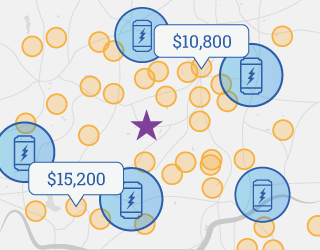Tesla’s new product isn’t an electric car or a solar tile design – instead, the company has announced a new utility-scale energy storage solution: the Tesla Megapack.
What is the Tesla Megapack?
The newest energy product from Tesla, the Megapack, is a large-scale battery storage solution that can be used to store electricity to be dispatched at a later time. Tesla has long been involved in the energy business, and with their acquisition of SolarCity in 2016, they solidified their investment in solar and battery storage. Tesla’s Powerwall battery, a residential energy storage solution, is one of the most popular home energy storage options available.
According to the Tesla website, the Megapack offers the same energy capacity as other large-scale storage solutions, but uses 40 percent less space and needs 10x fewer parts, meaning it can be installed 10x faster than current options. A single Megapack has several components all contained in a single housing unit. Battery modules, inverters, heat management systems, wiring, and more are all part of a Megapack unit.
Tesla Megapack news: what’s the latest?
The Tesla Megapack has made a splash in the utility-scale energy storage market. The news these days is quieter, but the company is being chosen for and completing Megapack installation projects for utilities, primarily in California. For example, Tesla was recently chosen to build a storage system for Apple in Northern California, as well as a system in Australia that aims to lower grid-related costs by $76 million.
How much energy can the Megapack store?
The Megapack has a maximum energy capacity of 3 megawatt-hours (MWh), equivalent to 3,000 kilowatt-hours (kWh). The Powerwall has 13.5 kWh of usable capacity, which means that the Megapack can store more than 200 times the energy of a single Powerwall.
Megapack vs. Powerpack: what’s the difference?
The Megapack isn’t Tesla’s first venture into large-scale energy storage products. Their previous product, the Powerpack, has already been deployed in multiple locations, most notably in South Australia, where Tesla built the then-largest lithium-ion storage system in the world. The 100-megawatt (MW) project provides significant benefits to the local grid; as of the end of 2018, the project had reduced costs associated with stabilizing the grid by nearly $28.9 million.
The Tesla Megapack can store 14 times more energy than the Powerpack, which has a capacity of only 210 kWh per unit. Importantly, this means that Tesla can save money on large-scale storage installations: installing a single Megapack unit will likely cost less than installing 14 Powerpacks, and will take less time as well.
What can the Tesla Megapack be used for?
Tesla’s website advertises the Megapack as being capable of “giga-scale projects”, meaning that the Megapack can be used in developing grid-tied storage systems in excess of 1 Gigawatt-hour (GWh) of energy capacity: that’s enough energy to power every home in San Francisco for 6 hours straight.
The Tesla Megapack debuted in the form of a 1.2 GWh storage project in PG&E territory in California, at Moss landing on Monterrey Bay. The project (which was approved in late 2018) uses 449 individual Megapacks. A battery system of this size can help utilities handle peak electricity demand and replace gas peaker plants that currently support the grid during times of high demand.
Energy storage can help you save at home
Beyond the benefits of installing battery energy storage at the grid-scale, there are plenty of reasons to pair one or more batteries with a solar panel system on your own property. Though there may only be one grid-scale solar + storage system, these types of installations are increasing in popularity for property owners throughout the country. If you’re interested in taking part in the solar + storage movement, register for a free account on EnergySage to receive custom solar or solar + storage quotes for your home.






